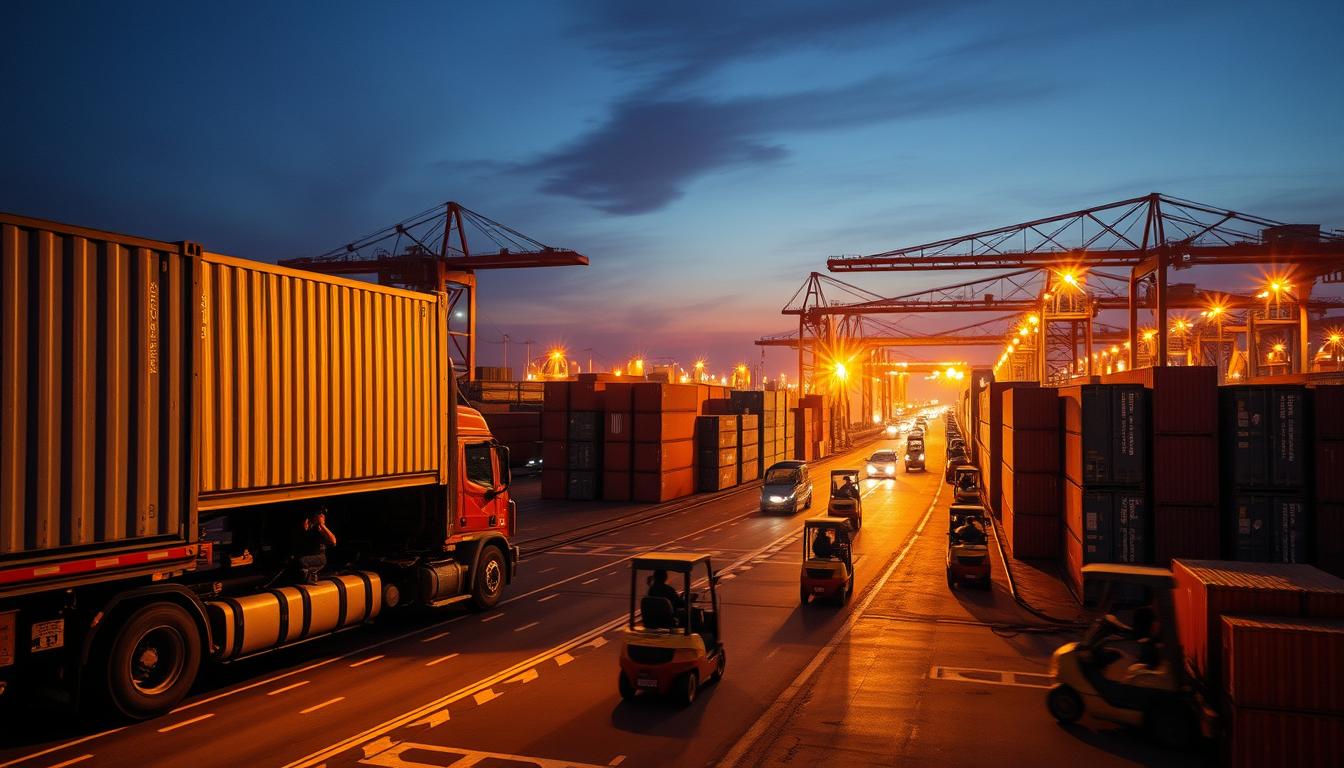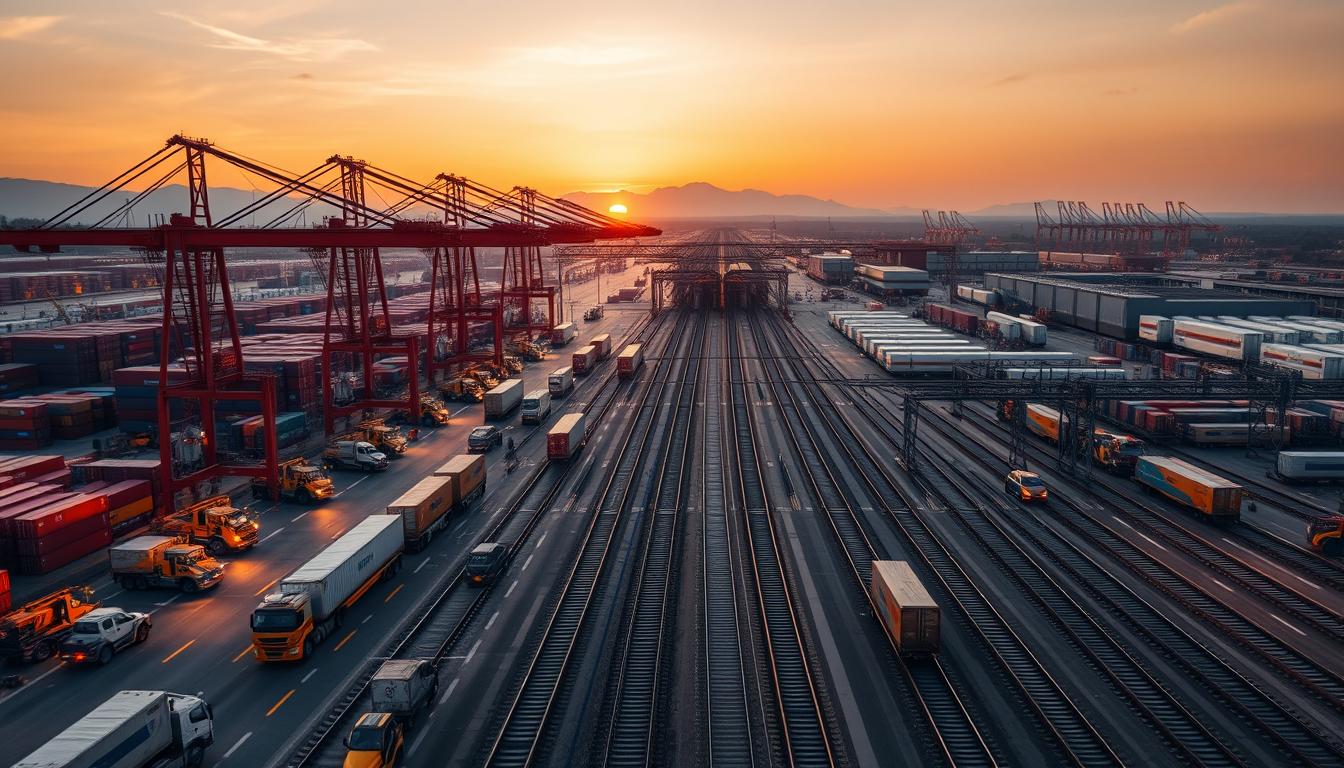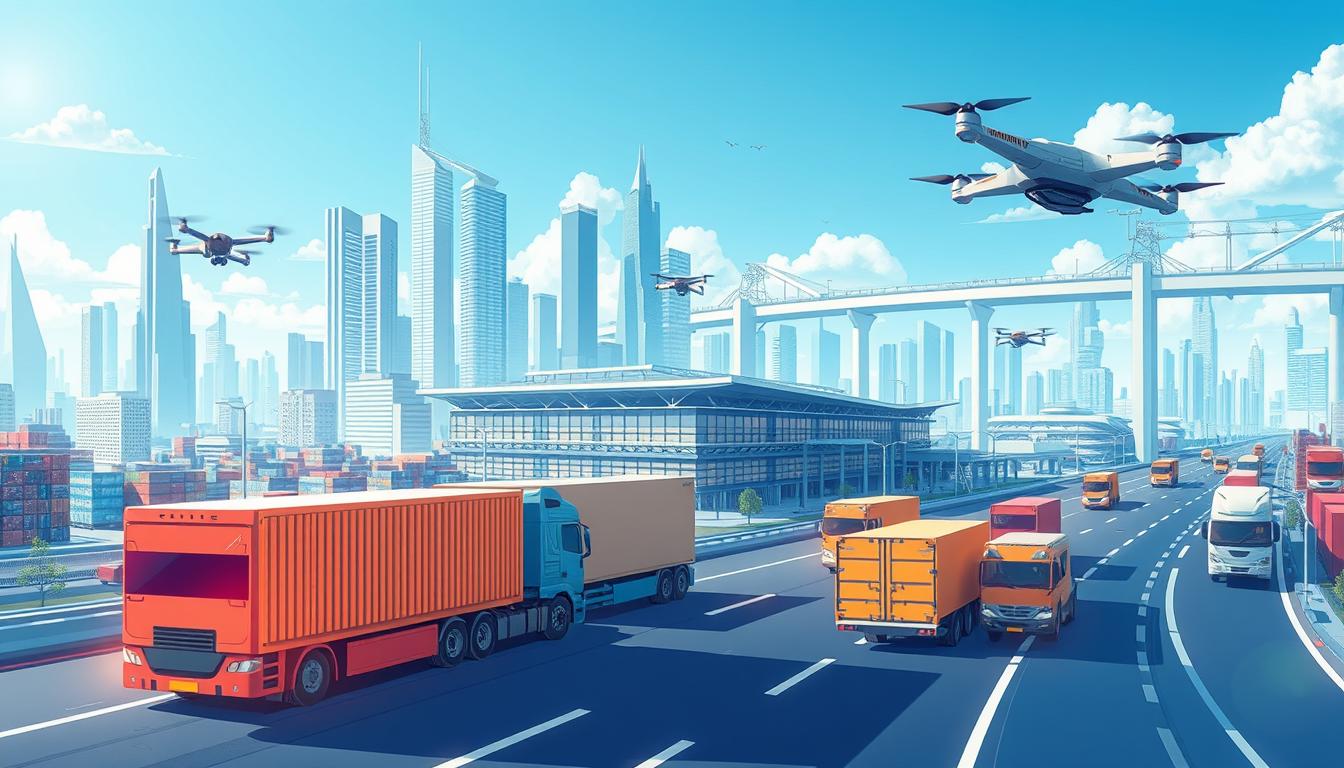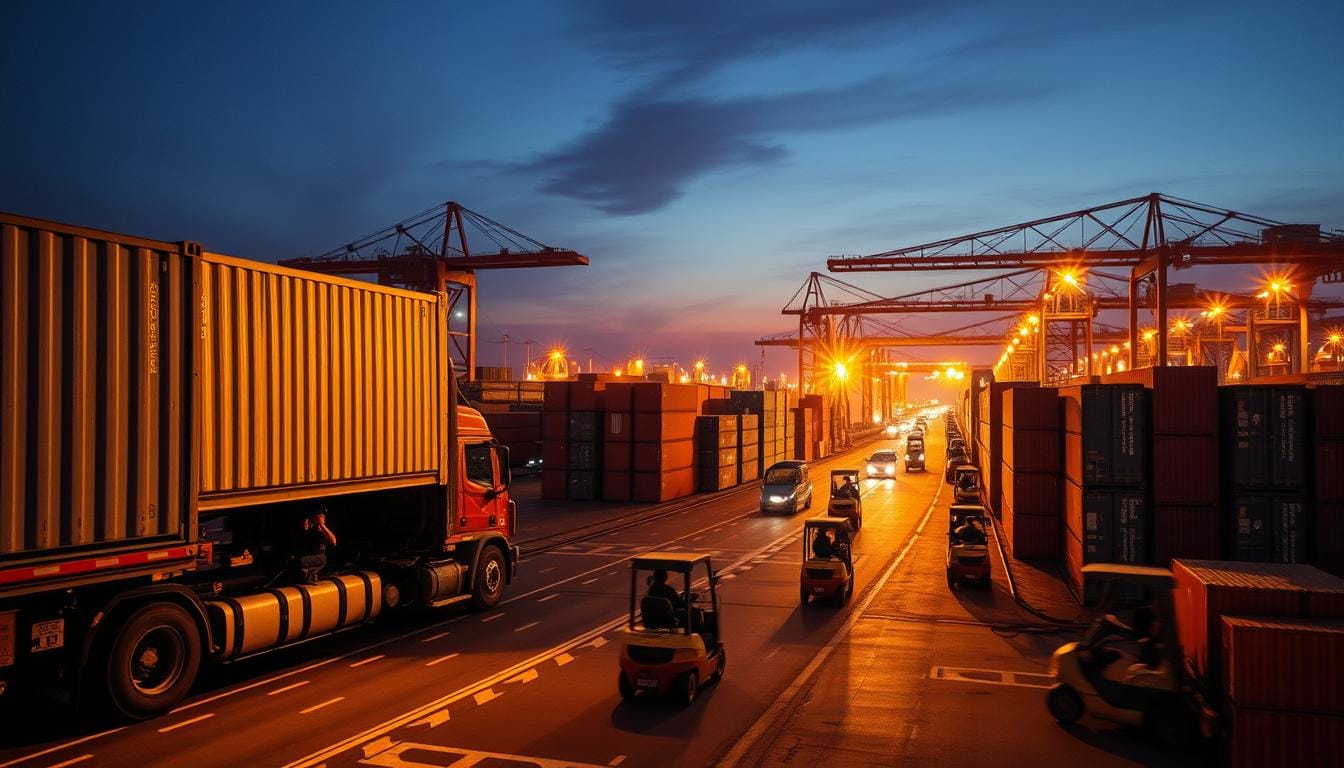Learn the fundamental freight logistics terminology, advantages, and emerging trends. Enhance your supply chain efficiency.
In today’s global economy, the efficient movement of goods is crucial for businesses to thrive. Freight logistics plays a vital role in ensuring that products are delivered on time and in the right condition.
Logistics management involves the planning, coordination, and execution of the movement and storage of goods, from origin to destination. A well-managed supply chain is essential for companies to remain competitive.

As the global trade landscape continues to evolve, understanding the terminology, benefits, and trends in freight logistics is becoming increasingly important. This article will provide an in-depth look at the key aspects of freight logistics and their impact on businesses.
Key Takeaways
- Freight logistics is crucial for the global economy.
- Effective logistics management ensures timely delivery.
- A well-managed supply chain is vital for business competitiveness.
- Understanding freight logistics terminology is essential.
- Staying up-to-date with trends in freight logistics is important for businesses.
The Fundamentals of Freight Logistics
Freight logistics is a critical component of modern supply chain management, enabling the efficient movement of goods across various distances. It involves a complex network of processes, including transportation, warehousing, and inventory management, all aimed at delivering products to the right place at the right time.
Definition and Core Concepts
Freight logistics refers to the management of the flow of goods from the point of origin to the point of consumption. It encompasses various activities, such as transportation planning, freight forwarding, and warehousing, to ensure the smooth movement of goods.
The Role of Freight Logistics in Supply Chain
Freight logistics plays a vital role in supply chain management, as it directly impacts the efficiency and cost-effectiveness of the entire supply chain. Effective freight logistics can help reduce transit times, lower transportation costs, and improve customer satisfaction.
| Key Components | Description | Benefits |
|---|---|---|
| Transportation Planning | Determining the most efficient transportation modes and routes | Reduced transit times, lower costs |
| Freight Forwarding | Coordinating the movement of goods on behalf of the shipper | Simplified logistics, improved visibility |
| Warehousing | Storing goods in a secure, climate-controlled environment | Improved inventory management, reduced damage |
7 Essential Freight Logistics Terminology You Should Know
Freight logistics terminology encompasses a range of concepts and definitions critical to the smooth operation of supply chains. Understanding these terms is vital for businesses to navigate the complex world of freight logistics effectively.
Transportation Terms
Transportation terms are fundamental to freight logistics. They define how goods are moved from one place to another.
FOB, FTL, LTL, and Drayage
Key transportation terms include FOB (Free on Board), which indicates when the liability for goods transfers from seller to buyer; FTL (Full Truckload) and LTL (Less Than Truckload), which refer to shipment sizes and their associated costs; and Drayage, the process of moving containers or cargo over short distances, typically within a port or terminal area.
Documentation Terms
Accurate documentation is crucial in freight logistics, ensuring that shipments are processed correctly and efficiently.
Bill of Lading, Freight Bill, and Proof of Delivery
Bill of Lading serves as a receipt of shipment and a contract between the shipper and carrier. The Freight Bill is an invoice from the carrier to the shipper for the transportation services provided. Proof of Delivery confirms that the goods were delivered to the consignee.
Pricing and Operational Terms
Pricing and operational terms affect how freight logistics services are priced and managed.
Accessorial Charges, Detention, and Demurrage
Accessorial Charges are additional fees for services beyond standard transportation, such as loading or unloading. Detention refers to charges incurred when a truck is delayed beyond a certain time frame. Demurrage is a fee for the extended use of a container or railcar beyond the allotted free time.
Video source from youtube
5 Major Freight Transportation Modes in Modern Logistics
The global logistics landscape is dominated by five primary freight transportation modes, each with its unique advantages and applications. Understanding these modes is crucial for businesses to make informed decisions about their supply chain strategies.
Road Freight Transportation
Road freight is one of the most flexible and widely used transportation modes. It offers door-to-door service, making it ideal for short to medium distances.
Truckload and Less-Than-Truckload Services
Truckload (TL) services involve the exclusive use of a truck for a single shipment, while Less-Than-Truckload (LTL) services consolidate multiple shipments from different shippers into a single truck. LTL is cost-effective for smaller shipments.
Rail Freight Services
Rail freight is an efficient mode for transporting large volumes over long distances. It’s particularly useful for heavy or bulky goods.
Ocean Freight Options
Ocean freight is the backbone of international trade, offering a cost-effective solution for global shipments.
Container Shipping vs. Break Bulk
Container shipping involves transporting goods in standardized containers, while break bulk refers to the transportation of goods individually or in pallets. Container shipping is more common due to its efficiency.
Air Freight Solutions
Air freight is the fastest mode of transportation, ideal for time-sensitive or high-value goods.
Intermodal Transportation Benefits
Intermodal transportation combines multiple modes (e.g., road, rail, ocean) to optimize the shipping process. It offers flexibility, cost savings, and reduced transit times.
6 Key Benefits of Optimized Freight Logistics
The benefits of optimized freight logistics are multifaceted, ranging from cost savings to enhanced customer satisfaction. By effectively managing freight logistics, businesses can achieve significant improvements in their operations and customer relations.
Cost Reduction Opportunities
Optimizing freight logistics can lead to substantial cost savings. By streamlining transportation routes and reducing unnecessary expenses, companies can lower their overall logistics costs. This can be achieved through better route planning, shipment consolidation, and renegotiating contracts with carriers.
Improved Customer Satisfaction
Enhanced freight logistics leads to faster and more reliable deliveries, directly improving customer satisfaction. By providing accurate tracking information and ensuring on-time deliveries, businesses can build trust with their customers and improve their overall customer experience.

Enhanced Supply Chain Visibility
Optimized freight logistics provides greater visibility into the supply chain. With real-time tracking and monitoring, businesses can quickly identify and address any issues that arise, ensuring a smoother supply chain operation.
Inventory Management Improvements
Effective freight logistics management can also lead to improvements in inventory management. By having a more accurate and timely understanding of shipments, businesses can better manage their inventory levels, reducing the need for excess stock and minimizing stockouts.
Risk Mitigation Strategies
Optimizing freight logistics involves implementing strategies to mitigate risks such as delays, damages, and losses. By diversifying transportation modes and having contingency plans in place, businesses can reduce their exposure to potential disruptions.
Competitive Advantage in the Marketplace
Ultimately, businesses that optimize their freight logistics gain a competitive advantage in the marketplace. By offering faster, more reliable, and cost-effective logistics solutions, companies can differentiate themselves from their competitors and attract more customers.
- Cost savings through efficient logistics management
- Improved customer satisfaction through timely deliveries
- Enhanced supply chain visibility for better decision-making
- Better inventory management to reduce costs and stockouts
- Risk mitigation strategies to protect against disruptions
- A competitive edge in the market through superior logistics
4 Common Challenges in Freight Logistics Management
The complexities of freight logistics management present several challenges that can hinder operational success. These challenges can impact various aspects of the supply chain, from capacity and cost to compliance and delivery.
Capacity Constraints and Driver Shortages
One of the significant challenges in freight logistics is capacity constraints, often exacerbated by driver shortages. This can lead to delayed shipments and increased costs. Companies must adopt strategies like dynamic routing and scheduling to optimize their capacity.
Rising Transportation Costs
Rising transportation costs pose another significant challenge. As fuel prices fluctuate and labor costs rise, logistics companies must find ways to reduce their operational expenses without compromising service quality.
Regulatory Compliance Complexities
Regulatory compliance is a complex issue in freight logistics, with various laws and regulations governing different aspects of transportation. Staying compliant requires continuous monitoring and adaptation to new regulations.
Last-Mile Delivery Optimization
Last-mile delivery is often the most challenging and expensive part of the logistics process. Optimizing this stage involves leveraging technology, such as route optimization software, to ensure timely and cost-effective delivery.
| Challenge | Impact | Potential Solution |
|---|---|---|
| Capacity Constraints | Delayed shipments, increased costs | Dynamic routing and scheduling |
| Rising Transportation Costs | Reduced profit margins | Cost-saving measures, efficient routing |
| Regulatory Compliance | Legal penalties, reputational damage | Continuous monitoring, compliance training |
| Last-Mile Delivery | High costs, customer dissatisfaction | Route optimization software, flexible delivery options |
8 Emerging Trends Reshaping the Future of Freight Logistics
The freight logistics industry is on the cusp of a revolution, driven by emerging trends that promise to transform how goods are transported. As technology continues to advance, the sector is witnessing significant changes that are expected to enhance efficiency, reduce costs, and improve customer satisfaction.
Digital Freight Matching Platforms
Digital freight matching platforms are connecting shippers with carriers more efficiently, reducing empty miles and lowering costs. These platforms use algorithms to match freight with available capacity, streamlining the process and improving supply chain visibility.
Autonomous Vehicles and Drones
The introduction of autonomous vehicles and drones is set to revolutionize last-mile delivery and long-haul transportation. These technologies promise to reduce labor costs and increase delivery speed.

Blockchain for Supply Chain Transparency
Blockchain technology is being adopted to enhance supply chain transparency and security. By creating an immutable record of transactions, blockchain helps to reduce fraud and improve trust among stakeholders.
| Trend | Impact | Benefit |
|---|---|---|
| Digital Freight Matching | Increased Efficiency | Reduced Costs |
| Autonomous Vehicles | Improved Delivery Speed | Lower Labor Costs |
| Blockchain Technology | Enhanced Transparency | Reduced Fraud |
Artificial Intelligence and Machine Learning Applications
AI and ML are being used to optimize routes, predict demand, and improve supply chain resilience. These technologies enable logistics companies to make data-driven decisions.
Internet of Things (IoT) in Freight Tracking
IoT devices are providing real-time tracking and monitoring of shipments, enhancing visibility and reducing the risk of loss or damage.
Sustainable and Green Logistics Initiatives
The industry is shifting towards more sustainable practices, including the use of electric vehicles and alternative fuels, to reduce its environmental impact.
E-commerce Impact on Freight Demands
The rise of e-commerce is driving changes in freight demands, with a greater need for fast and flexible delivery options.
Warehouse Automation Technologies
Automation is transforming warehouse operations, improving efficiency and reducing labor costs through the use of robots and automated storage systems.
5 Best Practices for Optimizing Your Freight Logistics Strategy
Optimizing freight logistics is crucial for businesses to stay competitive in today’s fast-paced global market. To achieve this, companies can implement several best practices that enhance their logistics operations.
Implementing Transportation Management Systems
Transportation Management Systems (TMS) are vital for optimizing freight logistics. They help in planning, executing, and tracking shipments, thereby improving efficiency and reducing costs.
Strategic Shipment Consolidation
Consolidating shipments can significantly reduce transportation costs. By combining multiple shipments into a single load, businesses can achieve economies of scale and lower their carbon footprint.
Building Strong Carrier Relationships
Developing strong relationships with carriers is essential for reliable and cost-effective logistics. This involves negotiating favorable rates, ensuring timely pickups, and resolving issues promptly.
Data-Driven Decision Making
Utilizing data analytics is crucial for making informed decisions in freight logistics. Key Performance Indicators (KPIs) such as on-time delivery rates, transit times, and cost per mile help in assessing performance.
Key Performance Indicators to Track
- On-time delivery rates
- Transit times
- Cost per mile
- Shipment damage rates
Continuous Improvement Methodologies
Adopting continuous improvement methodologies like Lean or Six Sigma can help logistics companies identify inefficiencies and implement corrective actions. This leads to ongoing enhancements in their operations.
Effective Freight Logistics: The Key to Supply Chain Efficiency
Understanding freight logistics is crucial for businesses seeking to optimize their supply chain operations. By grasping the terminology, benefits, and trends in freight logistics, companies can make informed decisions that improve their overall logistics management.
A well-optimized freight logistics strategy can lead to significant improvements in supply chain efficiency and competitiveness. By leveraging the right transportation modes, implementing effective logistics management practices, and staying abreast of emerging trends, businesses can reduce costs, enhance customer satisfaction, and gain a competitive edge in the marketplace.
In summary, a comprehensive understanding of freight logistics is essential for businesses to navigate the complexities of modern supply chains. By applying the insights and best practices outlined in this article, companies can develop a robust freight logistics strategy that drives long-term success and provides a freight logistics conclusion that reinforces their position in the market, ultimately leading to a logistics management summary that highlights their ability to adapt and thrive.
FAQ
What is freight logistics?
Freight logistics refers to the management of the flow of goods, resources, and related information from the point of origin to the point of consumption.
What are the different modes of freight transportation?
The different modes of freight transportation include road, rail, ocean, air, and intermodal transportation.
What is FOB, and how does it impact freight logistics?
FOB, or Free on Board, is a shipping term that indicates when the ownership of goods transfers from the seller to the buyer. It can impact freight logistics by determining who is responsible for the goods during transportation.
What is the difference between FTL and LTL shipping?
FTL, or Full Truckload, shipping involves dedicating an entire truck to a single shipment, while LTL, or Less Than Truckload, shipping involves consolidating multiple shipments from different shippers into a single truck.
How can digital freight matching platforms benefit my business?
Digital freight matching platforms can benefit your business by streamlining the process of finding and booking freight capacity, reducing costs, and increasing efficiency.
What is the role of blockchain in supply chain transparency?
Blockchain technology can provide a secure and transparent way to track and verify transactions, improving supply chain visibility and reducing the risk of counterfeiting or tampering.
How can I optimize my freight logistics strategy?
You can optimize your freight logistics strategy by implementing transportation management systems, consolidating shipments, building strong carrier relationships, and using data-driven decision making.
What are some emerging trends in freight logistics?
Some emerging trends in freight logistics include the use of autonomous vehicles, drones, artificial intelligence, and the Internet of Things (IoT) to improve efficiency, reduce costs, and enhance supply chain visibility.
How can I mitigate risks in my freight logistics operations?
You can mitigate risks in your freight logistics operations by developing contingency plans, diversifying your carrier base, and staying up-to-date with regulatory changes and industry trends.
What are some key performance indicators (KPIs) to track in freight logistics?
Some key performance indicators to track in freight logistics include on-time delivery rates, transit times, freight spend, and damage or loss rates.

